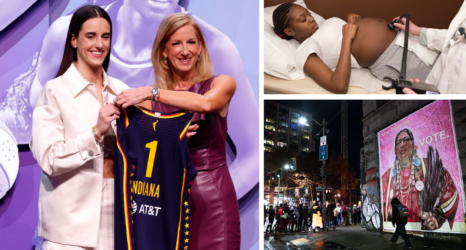The devastation of Hurricane Harvey this week prompted a Newsweek piece looking at how women are impacted by natural disasters. It carried this warning: Domestic violence and sexual assaults spike in post-disaster environments, as happened following Hurricane Katrina in New Orleans.
Globally, post-crisis responses often lack consideration for issues impacting women. Will the Harvey response include efforts to ensure women’s safety? The UN has more on what that could look like.
In coverage this week, the news media has generally focused on ways the storm has united our divided nation across gender, racial and political divides. That said, I definitely noticed how many images of the storm show men saving women—like the viral image of Houston Police SWAT officer Daryl Hudeck rescuing Catherine Pham as she holds her 13-month-old son. The National Review seized on these images to make a shortsighted attack on feminism, saying the many photographs of men rescuing women in flood waters “seem so instinctively right.” Those who had criticized “toxic masculinity” in the past, they wrote, should start appreciating manhood.
Most first responders are men, and they should they be honored and appreciated. Journalists must capture their work accurately, regardless of whether such images reinforce stereotypes about masculine strength and feminine weakness. But journalists should also make sure they’re telling the whole story—especially when we know the overwhelming majority of photographers and photo editors are also men, and may naturally reflect their worldview in choosing what images to prioritize.
Women may not be the ones carrying bodies out of submerged houses and cars, but their role in conflict and post-disaster goes far beyond victimhood. Consider the two female journalists who reported “Boomtown, Flood Town” last year—examining Houston’s vulnerability to floods. Or Dr. Kathleen Rasmussen, a female OB-GYN in Houston whose medical team helped keep alive a baby born at the height of the storm. Worldwide, when journalists make an effort, we see women’s role in post-disaster and conflict prevention as much more than passive—such as in this story on Burundi women pushing for an end to the civil war, or former Colombian female guerrillas grappling with peace.
The best journalists go that extra step to actively give voice to different communities in times of crisis. My favorite example this week was close to home: The World’s Carol Hills interviewed the president of the Islamic Society of Greater Houston, M.J Khan, about mosques opening their doors to flood victims. It brought me to happy tears. Give it a listen as you go into your long weekend.
This Week in Women is part of a series produced in partnership between the Ms. Blog, the Fuller Project for International Reporting and PRI’s Across Women’s Lives. This column is also part of a newsletter by Across Women’s Lives at PRI’s The World. Sign up and receive it regularly here.





